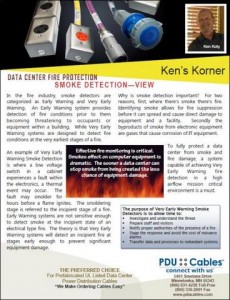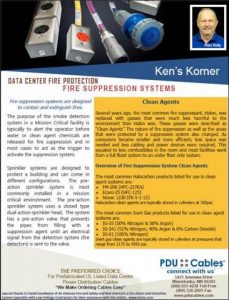KEN'S KORNER - Fire Suppression
Data Center - Fire Protection - Fire Suppression Systems
Data Center Fire Protection - Fire Suppression Systems
Fire suppression systems are designed to contain and extinguish fires.
Smoke detection system in a Mission Critical facility are designed to alert the operator before water or clean agent chemicals are released for fire suppression and in most cases act as the trigger to activate the suppression system.
Sprinkler systems are designed to protect a building.
Pre-action sprinkler systems employ check valves to hold back the water until a separate (flame, smoke, heat) detection system tied to the pre-action check valve sense there is a fire. Once the detection system is activated, it will open the pre-action check valve filling the system with water, or other fire suppressant. The fire suppressant will not discharge until a fire sprinkler head actually fuses allowing the suppressant to flow onto the fire.
Pre-action system piping will also be pressurized with air or nitrogen to monitor piping for leaks or breakage. Loss of air will notify the alarm panel there is a problem.
Clean Agents
Several years ago, the most common fire suppressant, Halon (an Ozone depleting Chlorofluorocarbon gas), was replaced with gasses that were much less harmful to the environment than Halon was. These gasses were described as “Clean Agents” The nature of fire suppression as well as the areas that were protected by a suppression system also changed. As computers became smaller and more efficient, less space was needed and less cabling and power devices were required, This equated to less combustibles in the room and most facilities went from a full flood system to an under floor only system.
Overview of Fire Suppression System Clean Agents
The most common Halocarbon products listed for use in clean agent systems are:
¨ FM-200 (HFC-227EA)
¨ Ecaro-25 (HFC-125)
¨ Novec 1230 (FK-5-1-12)
Halocarbon clean agents are typically stored in cylinders at 360psi.
The most common Inert Gas products listed for use in clean agent systems are:
¨ IG-55 (50% Nitrogen & 50% Argon)
¨ IG-541 (52% Nitrogen, 40% Argon & 8% Carbon Dioxide)
¨ IG-01 (100% Nitrogen)
Inert gas clean agents are typically stored in cylinders at pressures that range from 2175 to 4350 psi.
Pre-action sprinkler systems are ideally suited for water sensitive environments.
Fire Suppression Systems
David Goodwyne FPE, from J N Johnson Fire and Safety in Minneapolis, MN, offers these thoughts on fire suppression systems.
Clean agent fire suppression systems are primarily used to protect equipment of high value, high replacement cost, and/or high loss to critical infrastructure. Examples of equipment or items protected by clean agent fire suppression systems are: Computer Rooms, Data Centers, Telephone Equipment Rooms, Anechoic Chambers, Irreplaceable documents, Generator Enclosures, Mobile Phone Rooms, 911 call centers, and Engine test cells.
The reason that clean agent systems are preferred for the above mentioned applications is the desire of the owner to be able to extinguish a fire without the use of water. Most of the time the water sprinklers is still installed in the area or rooms where clean agents systems are in place, but the systems are designed such that the clean agent system would discharge, extinguishing the fire before the water sprinkler system activates. What this does is minimize the damage to the equipment from the fire significantly, therefore, helping the customer get their systems back online quickly.
Another benefit clean agents provide is that they are listed for use in “Normally Occupied” enclosures. A Normally Occupied Enclosure is defined as an enclosure where one or more persons are present under normal conditions. This means that there can be a fire in a data center where people are working and when the system discharges to extinguish the fire, the people in the enclosure are able to breathe the air with the clean agent in it for up to 5 minutes before leaving the space. The 5 minute limit is as defined and in NFPA 2001. Clean agents do not leave any residue on the equipment in the room, and it is environmentally friendly. In today’s world there are very few chemicals other than clean agents that are safe for people, safe for equipment, leave no residue, and extinguish a fire efficiently.
All clean agent fire suppression systems are designed based on the volume of the enclosure to be protected. Cylinder’s are sized and filled with clean agent based on the amount of clean agent needed to ensure fire suppression. Delivery of the clean agent to the space protected is accomplished using an engineered piping network and nozzles to uniformly discharge the clean agent in the room. Halocarbon type agents are required to discharge completely in 10 seconds while inert type agents must discharge completely within 60 seconds. The rapid discharge of the clean agent systems is important to get a good mixture of the clean agent gas to all parts of the enclosure.
The control panel that releases a clean agent suppression system is ideally located in the protected room with either VESDA or VIEW smoke detection systems, manual release stations, abort stations and bells, horns and strobes used for notification of personnel of an alarm condition.
All systems use the NFPA 2001 standard for the design of the various clean agents and NFPA 72 standard for the design of the control panel and all associated electrical devices.
As always fire detection and suppression remain one of the most critical aspects of good facility management in a mission critical facility.
Special thanks to David Goodwyne of JN Johnson Fire and Safety (www.jnjohnson.com) and Bob Hoertsch a Fire Alarm and Detection System Specialist with Low Voltage Contractors (www.lvcinc.com) for his assistance with this article.
Ken Koty,


